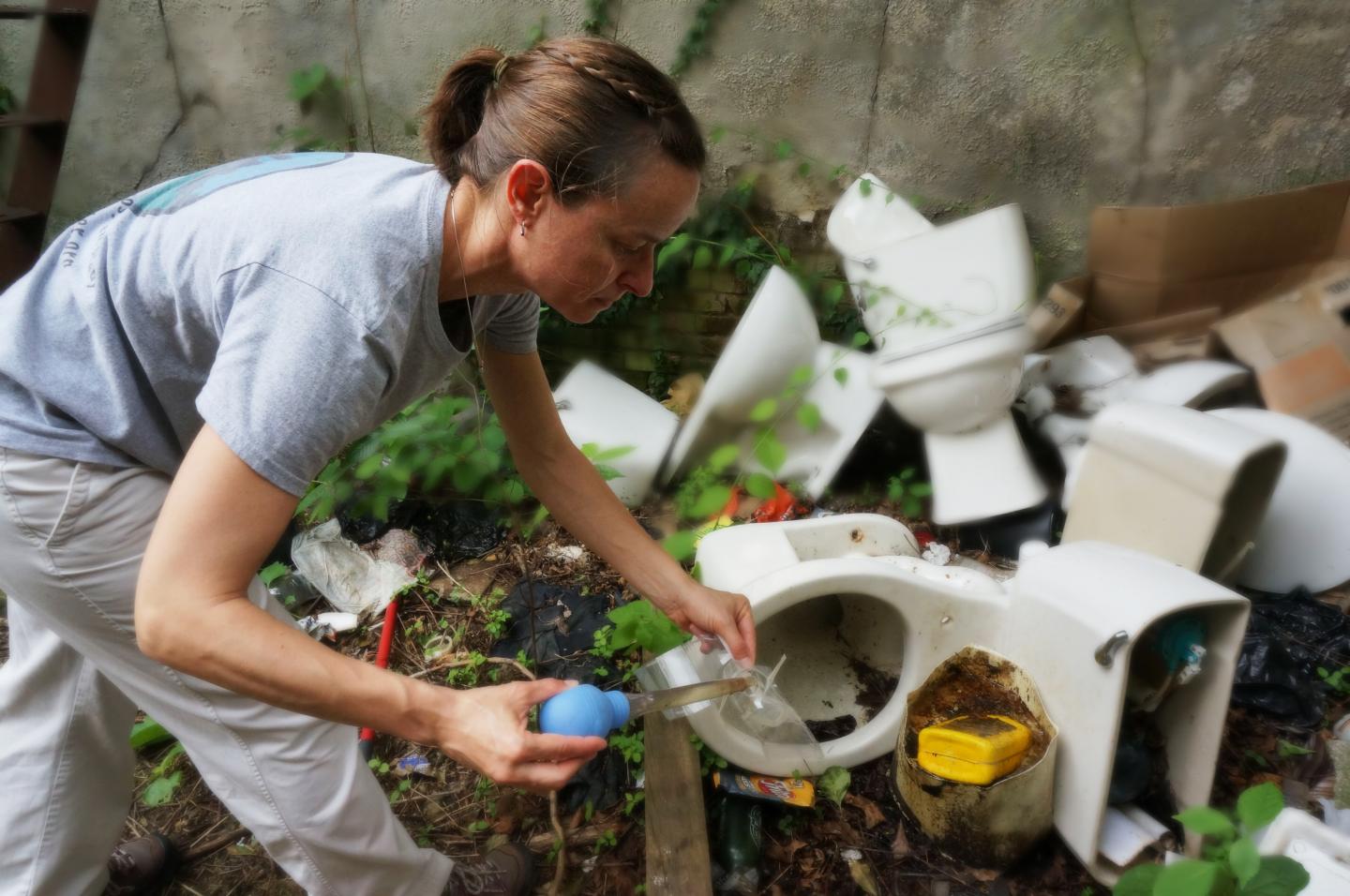
Credit: BES Photo Archive
(Millbrook, NY) A new study published in the Journal of Medical Entomology reports that in Baltimore, Maryland, neighborhoods with high levels of residential abandonment are hotspots for tiger mosquitoes (Aedes albopictus). This environmental injustice may leave low-income urban residents more vulnerable to mosquito-borne disease.
Shannon LaDeau, a disease ecologist at the Cary Institute of Ecosystem Studies and senior author on the paper, explains, "We are interested in how land cover, microclimate, and socioeconomics influence the distribution of tiger mosquitoes. In Baltimore and other temperate cities, the interplay of these factors determines when and where mosquitoes emerge and the extent to which they pose a risk to people."
Native to Asia, tiger mosquitoes arrived in the US in the 1980s, likely as stowaways on imported tires. They have quickly spread throughout the South and Northeast, where they thrive in cities. Unlike native mosquitoes, they feed during daylight hours and are known for living in close association with people.
Lead author Eliza Little, a doctoral candidate in the Department of Environmental Health Sciences at Columbia University, explains, "Tiger mosquitoes are highly tolerant and can reproduce in very small pools of water; a cap of water will suffice. They are known to transmit diseases such as dengue and chikungunya, with documented cases in Asia and Europe. They also have the potential to spread Zika."
The research team, which included scientists from the University of Maryland and Rutgers University, spent three years monitoring mosquito activity in five west Baltimore neighborhoods. Study sites spanned a gradient of low, medium, and high socioeconomic status neighborhoods. At each site, 33 blocks were identified as predominantly residential, excluding businesses, schools, and large apartment complexes.
Block-scale surveillance of mosquito breeding habitat was conducted three times during each season (in June, July, and September). Every three weeks, from May to September, adult mosquitoes were also sampled. Climate data from a NOAA station at the Maryland Science Center was used to track how rainfall influenced the development of larval mosquitoes.
To reveal how landscape features and vegetation influence mosquito prevalence, target neighborhoods were mapped using block-by-block surveys and Landsat satellite imagery. During ground surveys, researchers counted trees, abandoned buildings (officially condemned or with 148 boarded-up entry), parks, vacant lots, grassy areas, and trash with the potential to serve as breeding habitat.
High vegetation cover was found in both low and high income neighborhoods, but its impact on mosquito abundance differed. More mosquitoes were found in lower socioeconomic areas because vacant lots and abandoned buildings provide more breeding sites. Infrequent garbage removal is another issue, giving rise to semi-permanent dumping sites that attract mosquitoes.
The correlation between a neighborhood's socioeconomic status and mosquito abundance wasn't static. In low-income areas, rain-filled trash, abandoned and decaying properties, and overgrown lots create mosquito breeding habitat. In higher socioeconomic areas, mosquitoes are supported by residents who water their plants and lawns during the summer.
LaDeau explains, "In a city like Baltimore, hot, dry conditions should cause mosquito populations to decline. Instead, in higher income neighborhoods, residents water their yards and enable mosquito populations to survive. That said, overall, our surveys found much larger mosquito populations in lower income neighborhoods."
"This study highlights the dual needs for personalized mosquito control on a lot-by-lot basis and public education across different socioeconomic neighborhoods to implement effective control strategies," Little notes. Adding, "Our work can also inform urban greening strategies. There can be unintended consequences when green spaces are added to cities without first removing mosquito-sustaining containers."
By understanding the environmental conditions that give rise to mosquito populations, researchers can better predict and manage mosquitoes in urban areas, reducing environmental injustices and protecting public health.
LaDeau concludes, "This summer, if you want to reduce mosquito numbers, one the best things you can do is reduce water-holding containers in your community. After a rainfall, do a quick survey of your yard or neighborhood and address sites where water pools. Planters, clogged gutters, neglected pet dishes and bird baths, and trash all provide great tiger mosquito breeding grounds."
###
This study was made possible, in part, by support from the National Science Foundation, the Parks & People Foundation, the US Department of Agriculture, and the National Institutes of Health. It is a contribution to the Baltimore Ecosystem Study Long Term Ecological Research (BES LTER) Program.
Citation
E. Little, D. Biehler, P. T. Leisnham, R. Jordan, S. Wilson, S. L. LaDeau; Socio-Ecological Mechanisms Supporting High Densities of Aedes albopictus (Diptera: Culicidae) in Baltimore, MD. J Med Entomol 2017 tjx103. doi: 10.1093/jme/tjx103
The Cary Institute of Ecosystem Studies is one of the world's leading independent environmental research organizations. Areas of expertise include disease ecology, forest and freshwater health, climate change, urban ecology, and invasive species. Since 1983, Cary Institute scientists have produced the unbiased research needed to inform effective management and policy decisions.
Media Contact
Lori M Quillen
[email protected]
845-677-7600 x233
@CaryInstitute
http://www.caryinstitute.org
############
Story Source: Materials provided by Scienmag





